Chapter Two - The Death Census of 1847
Published online by Cambridge University Press: 17 October 2023
Summary
[…] the death census of 1846 and 1847 will form a new and astounding era in Irish history, and will be transmitted through generations yet unborn with increasing execrations of the present period and its policy, until the dead are summoned to rise again, and come to judgement.
During the depths of the harshest year of the Famine, ‘Black ‘47’, it may seem a little curious that leading Irish members of parliament were occupying themselves with matters of population and population counts. Such interests were not of recent vintage. The Irish were a much-counted people. Censuses and census-type surveys dated back to the seventeenth century and continued into the eighteenth century in large part driven by the insecurities of the British state and the Established Church in Ireland. Unlike Britain, the great majority of the inhabitants was Roman Catholic, of Gaelic and Old English stock, and hence suspect on grounds of religion and loyalty. The penal laws against Catholics and Protestant dissenters were progressively relaxed during the eighteenth century. By the end of that century, individuals within the Catholic community were expressing an interest in ascertaining the size and relative strength of the Catholic population. The first initiative of this kind was formulated by Edward Hay, scion of a prosperous landed family and later a leading advocate of Catholic rights, who in 1795 proposed a national religious census. The outbreak of regional rebellions in Ireland in 1798 put paid to this idea.
But the spirit of the age favoured such empirical inquiries, in part stimulated by the contributions of Thomas Malthus and his critics on the progress of population. Early in the new century, the political economist Thomas Newenham arranged with southern Catholic clergymen the collection of population estimates for their parishes. These partial surveys were published in his Population of Ireland and View of Ireland. A series of other informal surveys followed. There was even a suggestion that the Catholic clergy were especially well placed to conduct population counts. A prefiguration of later, Famine-time initiatives was the attempt by Daniel O’Connell's ‘Popish Parliament’ to organise a national religious census in Ireland in the 1820s. O’Connell was a strong critic of the 1821 statutory census which had reported a national population of 6.8 million.
- Type
- Chapter
- Information
- The Death Census of Black '47Eyewitness Accounts of Ireland's Great Famine, pp. 29 - 38Publisher: Anthem PressPrint publication year: 2023



